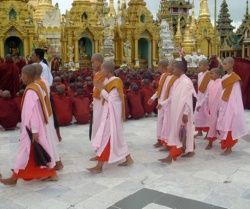Difference between revisions of "Five types of vision"
(Created page with " five types of vision 五眼 (Jpn go-gen ) Also, five types of eyes. Five kinds of perceptive {{Wiki|faculty}}. They are (1) the eye of ordinar...") |
|||
| Line 1: | Line 1: | ||
| + | <nomobile>{{DisplayImages|2911|2201}}</nomobile> | ||
| − | [[five types of vision]] | + | |
| − | [[五眼]] (Jpn [[go-gen]] ) | + | |
| + | |||
| + | [[five types of vision]]: [[五眼]] (Jpn [[go-gen]] ) | ||
Also, [[five types of eyes]]. | Also, [[five types of eyes]]. | ||
| − | Five kinds of perceptive | + | [[Five kinds of perceptive faculty]]. |
| + | |||
| − | They are | + | They are; |
| − | (1) the [[eye | + | (1) the [[eye of ordinary people]], also called the [[physical eye]], which distinguishes {{Wiki|color}} and [[form]]; |
| − | (2) the [[heavenly | + | (2) the [[heavenly eye]], also called the [[divine eye]], which [[perceives]] things in the {{Wiki|darkness}}, at a distance, or beyond the [[physical]] limits of obstruction; |
(3) the [[wisdom eye]], or the ability of those in the [[two vehicles]] to {{Wiki|perceive}} that nothing has {{Wiki|independent}} [[existence]] of its [[own]] and all [[phenomena]] are [[non-substantial]]; | (3) the [[wisdom eye]], or the ability of those in the [[two vehicles]] to {{Wiki|perceive}} that nothing has {{Wiki|independent}} [[existence]] of its [[own]] and all [[phenomena]] are [[non-substantial]]; | ||
| Line 20: | Line 24: | ||
(4) the [[Dharma eye]], with which [[bodhisattvas]] {{Wiki|perceive}} the [[nature]] of all teachings in order to save the [[people]]; and | (4) the [[Dharma eye]], with which [[bodhisattvas]] {{Wiki|perceive}} the [[nature]] of all teachings in order to save the [[people]]; and | ||
| − | (5) the [[Buddha eye]], which [[perceives]] the [[true nature | + | (5) the [[Buddha eye]], which [[perceives]] the [[true nature of life]] spanning {{Wiki|past}}, {{Wiki|present}}, and {{Wiki|future}}. |
| + | |||
| + | The [[Buddha eye]] includes all the other four [[eyes]], or perceptive faculties. | ||
| + | |||
| + | In other words, [[Buddhas]] possess all [[five types of vision]]. | ||
{{R}} | {{R}} | ||
http://www.sgilibrary.org/search_dict.php | http://www.sgilibrary.org/search_dict.php | ||
[[Category:Buddhas]] | [[Category:Buddhas]] | ||
Latest revision as of 22:06, 4 December 2015
five types of vision: 五眼 (Jpn go-gen )
Also, five types of eyes.
Five kinds of perceptive faculty.
They are;
(1) the eye of ordinary people, also called the physical eye, which distinguishes color and form;
(2) the heavenly eye, also called the divine eye, which perceives things in the darkness, at a distance, or beyond the physical limits of obstruction;
(3) the wisdom eye, or the ability of those in the two vehicles to perceive that nothing has independent existence of its own and all phenomena are non-substantial;
(4) the Dharma eye, with which bodhisattvas perceive the nature of all teachings in order to save the people; and
(5) the Buddha eye, which perceives the true nature of life spanning past, present, and future.
The Buddha eye includes all the other four eyes, or perceptive faculties.
In other words, Buddhas possess all five types of vision.

